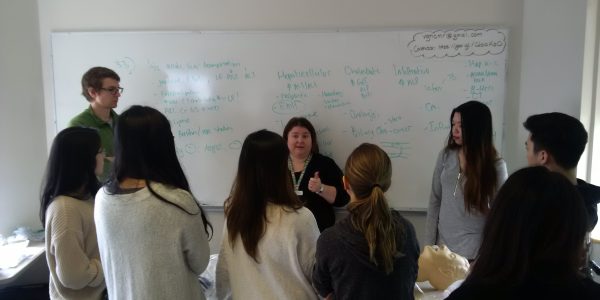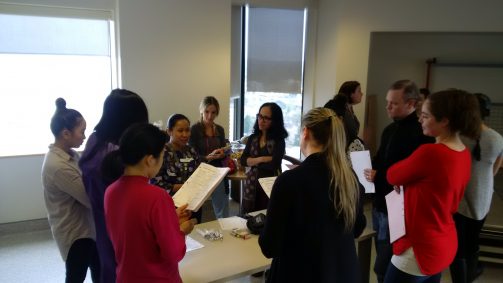Decoding Code Blue at VGH
It can send shivers up your spine.
When a Code Blue is called, an emergency situation – usually cardio-pulmonary arrest – is in progress. Appropriate resuscitative efforts are urgently needed and they’re usually initiated by nursing staff. It’s a high-stress situation and nurses on non-critical care units need to be proficient at responding until the Code Blue Team arrives.
On March 29, nurses from medicine units attended a four-hour Mock Code Blue training session developed and organized by education leaders of the VGH Medicine Program. Inspired by our VCH True North goals and People First philosophy, this education program aims to support nurses in developing valuable skills, confidence and better understanding of their important role in a Code Blue.
Offered for more than two years on a quarterly basis, the session is delivered as part of a standardized approach in nursing practice development. Developed in conjunction with Code Blue Response Skills from Course Catalogue Registration System (CCRS) and guided by American Heart Association (AHA) 2015 Guidelines, the training reviews appropriate actions and interventions care staff must perform during a Code Blue with a focus on the nurse’s role.
Training mimics real-life scenarios
Applying principles of adult education, the curriculum and lesson plan were developed and formalized in partnership with Regional Clinical Education. The training is case-based and follows the journey of an adult patient who deteriorates and codes in the hospital.
A one-hour session on deteriorating patient information is presented by the Critical Care Outreach Team to reinforce concepts on “early rescue.” This is supplemented by role play of Code Blue processes and code team are simulated to mimic real-life scenarios and responses. Nursing staff have opportunities to participate in the role play as ward responders and recorders.
Debriefing is also a vital component of the training as it provides a safe space for constructive discussion and reflection to enhance individual and team performance. Debriefs are facilitated twice within the training: once after nurses “respond” to a Code Blue, and once after a Code Blue ends.
With the support of VCH People and Culture Department, multiple-choice questions, short video and use of i-clickers are infused making the education interactive and engaging.
The training also provides hands-on experiences with use of learning stations:
- CPR
- Airway
- Documentation
- Basic Life Support (BLS) cart
Training receives rave reviews
Standardized evaluation assists the medicine team in reassessing the Mock Code Blue training, so that learning needs are consistently tailored and addressed. Based from recent evaluation:
- 96% of learners scored high for self-perceived knowledge of Code Blue concepts and skills after the training.
- 91% of learners scored high for self-perceived confidence and willingness to participate in a Code Blue after the training.
- 100% felt more prepared to participate in a Code Blue after the training.
Some of the feedback staff shared included:
- “Participating at learning stations for hands-on practice was very helpful!”
- “I learned about the role of nurses during code simulation”
- “The scenario was informative.”
- “Still nervous about codes, but I feel better about future encounters.”


